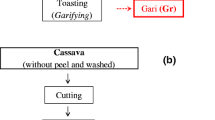Abstract
PutativePseudomonas spp. (102 isolates) from different foods were first characterised by API 20NE and then tested for some enzymatic activities (lipase and lecithinase production, starch hydrolysis and proteolytic activity). However subsequent molecular tests did not always confirm the results obtained, thus highlighting the limits of API 20NE. Instead RFLP ITS1 and the sequencing of 16S rRNA gene grouped the isolates into 6 clusters:Pseudomonas fluorescens (cluster I),Pseudomonas fragi (duster II and V)Pseudomonas migulae (cluster III),Pseudomonas aeruginosa (cluster IV) andPseudomonas chicorii (cluster VI). The pectinolytic activity was typical of species isolated from vegetable products, especiallyPseudomonas fluorescens. InsteadPseudomonas fragi, predominantly isolated from meat was characterised by proteolytic and lipolytic activities.
Similar content being viewed by others

References
Alm E.W., Oether D.B., Larsen N., Sthal D.A., Raskin L. (1996). The oligonucleotide probe database. Appl. Environ. Microbiol., 62: 3557–3559.
Arnaut-Rollier I., Vauterin L., De Vos P., Massart D.L., Devriese L.A., De Zutter L., Van Hoof J. (1999). A numerical taxonomic study of thePseudomonas flora isolated from poultry meat. J. Appl. Microbiol., 87: 15–28.
Dogan B., Boor K.J. (2003). Genetic diversity and spoilage potentials amongPseudomonas from fluid milk products and dairy processing plants. Appl. Environ. Microbiol., 69: 130–138.
Franzetti L., Martinoli S., Piergiovanni L., Galli A. (2001). Influence of active packaging on the shelf-life of Minimally Processed Fish products in a modified atmosphere. Packag. Technol. Sci., 14: 267–274.
Garcia-Lopez I., Otero A., Garcia-Lopez M-L., Santos J.A. (2004). Molecular and phenotypic characterization of nonmotile Gram-negative bacteria associated with spoilage of freshwater fish. J. Applied Microbiol., 96: 878–886.
Gram L., Huss H.H. (1996). Microbiological spoilage of fish and fish products. Int. Food Microbiol., 33: 121–137.
Guasp C., Moore E.R.B., Lalucat J., Bennasar A. (2000). Utility of internally transcribed 16S–23S rDNA spacer regions for the definition ofPseudomonas stutzerii genomovars and otherPseudomonas species. Int. J. Syst. Evol. Microbiol., 50: 1629–1639.
Hugh R., Leifson E (1953). The taxonomic significance of fermentative versus oxidative metabolism of carbohydrates by various Gram negative bacteria. J. Bacteriol., 66: 24–26.
Johnsen K., Andersen S., Jacobsen C.S. (1996). Phenotypic and genotypic characterization of phenanthrene-degrading fluorescentPseudomonas biovars. Appl. Environ. Microbiol., 62 (10): 3818–3825
Johnsen K., Enger O., Jacobens C.S., Thirupo L., Torsvik V. (1999). Quantitative selective PCR of 16S ribosomal DNA correlates well with selective agar plating in describing population dynamics of indigenuousPseudomonas spp. in soil hot spots. Appl. Environ. Microbiol., 65(4): 1786–1789.
Johnson J.L., Palleroni N.J. (1989). Deoxyribonucleic acid similarities amongPseudomonas species. Int. J. Syst. Bacteriol., 39: 230–235.
King E.O., Ward M.K., Rancy D.E. (1954). Two simple media for the demonstration of pyocianin and fluorescin. J. Lab. Med., 44: 301–307.
Kozo O. (1995). Comparative ribosomal protein sequence analyses of a phylogenetically defined genus,Pseudomonas, and its relatives. Int. J. Syst. Bacteriol., 45 (2): 268–273.
Lane D.J., Pace B., Olsen G.J., Stahl D.A., Sogin M.L., Pace N.R. (1985). Rapid determination of 16S ribosomal RNA sequences for phylogenetic analysis. Proc. Nat. Acad. Sci. USA, 82: 6955–6959.
Lelliot R.A., Billing E., Hayaward A.C. (1966). A determinative medium for the fluorescent plant pathogenicPseudomonas. J. Appl. Bacteriol., 29: 470–489.
Miller III A., Scanlan R.A., Lee J.S., Libbey L.M. (1993) Identification of volatile compounds produced in sterile fish muscle (Sebastes melanops) byPseudomonas fragi. Appl. Microbiol., 25: 952–955
Molin G., Ternstrom A. (1986). Phenotypically based taxonomy of psychrotrophicPseudomonas isolated from spoiled meat, water and soil. Int. J. Syst. Bacteriol., 36: 257–274.
Moore E.R.B., Mau M., Arascheidt A., Bottger E.C., Hutson R.A., Collins M.D., Van de Peer Y., De Wachter R., Timmis K.N. (1996). The determination and comparison of the rRNA gene sequences of species of the genusPseudomonas (sensu stricto) and estimation of natural intrageneric relationships. Syst. Appl. Microbiol., 19: 478–492.
Ngyen-The C., Carlin F. (1994). The microbiology of minimally processed fresh fruit and vegetable. Critical Reviews Food Sci. Nutr., 34 (4): 371–401.
Palleroni N.J. (1984). Genus I.Pseudomonas Migula 1894. In: Krieg N.R., Holt J.G., Eds, Bergey’s Manual of Systematic Bacteriology, Vol. 2, Williams & Wilkins, Baltimore MD, pp. 141–199.
Palleroni N.J., Doudoroff M. (1972). Some properties and taxonomic subdivision of the genusPseudomonas. Ann. Rev. Phytopath., 10: 73–100.
Palleroni N.J., Kunisawa R., Contopoulou R., Doudoroff M. (1973). Nucleic acid homologies in the genusPseudomonas. Int. J. Syst. Bacteriol., 23: 333–339.
Palleroni N.J. (1991a). Human and animal pathogenicPseudomonas. In: Balows A, Ed., The Prokaryotes. Springer Verlag, New York, pp. 3086–3103.
Palleroni N.J. (1991b). Introduction to the family Pseudomonadaceae. In: Balows A, Ed., The Prokaryotes, Springer Verlag, New York, pp. 3072–3085.
Palleroni N.J. (1993).Pseudomonas classification. Ant. Leew., 64: 231–251.
Ridgway H.F., Safarik J. (1990). Identification and catabolic activity of well-derived gasoline-degrading bacteria from a contaminated aquifer. Appl. Environ. Microbiol., 56: 3565–3575.
Riva M., Franzetti L., Galli A. (2001). Microbiological quality of shelf-life modelling of ready to eat cicorino. J. Food Prot., 64 (2): 228–234.
Rohlf F.J. (1987). NTSYS-PC: Numerical taxonomy and multivariate analysis system for IBM PC Microcomputer (and compatibles), Version 1.30. Applied Biostatistics, New York.
Sand S., Hankin L., Zucker M. (1972). A selective medium for pectinolyticPseudomonas. Phytopatology, 62: 998–1000.
Scarpellini M., Franzetti L., Galli A. (2004). Development of PCR assay to identifyPseudomonas fluorescens and its biotype. FEMS Microbiol. Lett., 236 (2): 257–260.
Sierra G. (1957). A simple method for the detection of lypolitic activity of microorganisms and some observations on the influence of the contact between cells and fatty substrates. Ant. van Leeuw., 23: 115–122.
Sneath P.H.A., Sokal R.R. (1973) Numerical Taxonomy. The Principles and Practice of Numerical Classification. W.H. Freeman, San Francisco, Californy.
Stanier R.Y., Palleroni N.J., Doudoroff M. (1966). The aerobic Pseudomonads: a taxonomy study. J. Gen. Microbiol., 43: 159–271.
Tryfinopoulou P., Tsakalidon E., Nychas G.-J.E. (2002). Characterization ofPseudomonas sp. associated with spoilage of Gilt-head sea bream stored under various conditions. Appl. Environ. Microbiol., 68 (1): 65–72.
Wiedmann, M., Weilmeier D., Dineen S.S., Ralyea R.M., Boor K.J. (2000). Molecular and Phenotypic characterization ofPseudomonas spp. isolated from milk. Appl. Environ. Microbiol., 66 (5): 2085–2095.
Author information
Authors and Affiliations
Corresponding author
Rights and permissions
About this article
Cite this article
Franzetti, L., Scarpellini, M. Characterisation ofPseudomonas spp. isolated from foods. Ann. Microbiol. 57, 39–47 (2007). https://doi.org/10.1007/BF03175048
Received:
Accepted:
Issue Date:
DOI: https://doi.org/10.1007/BF03175048



